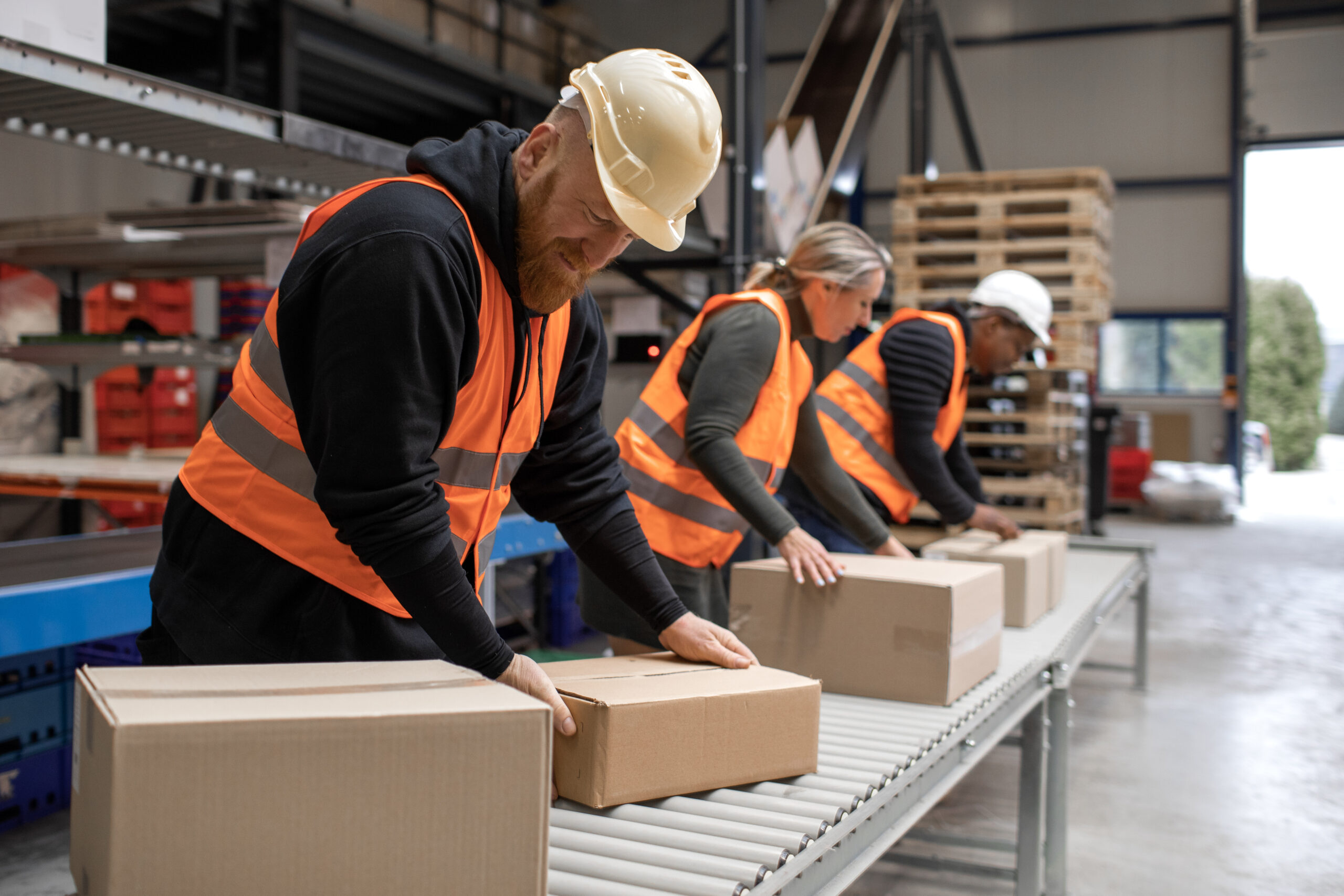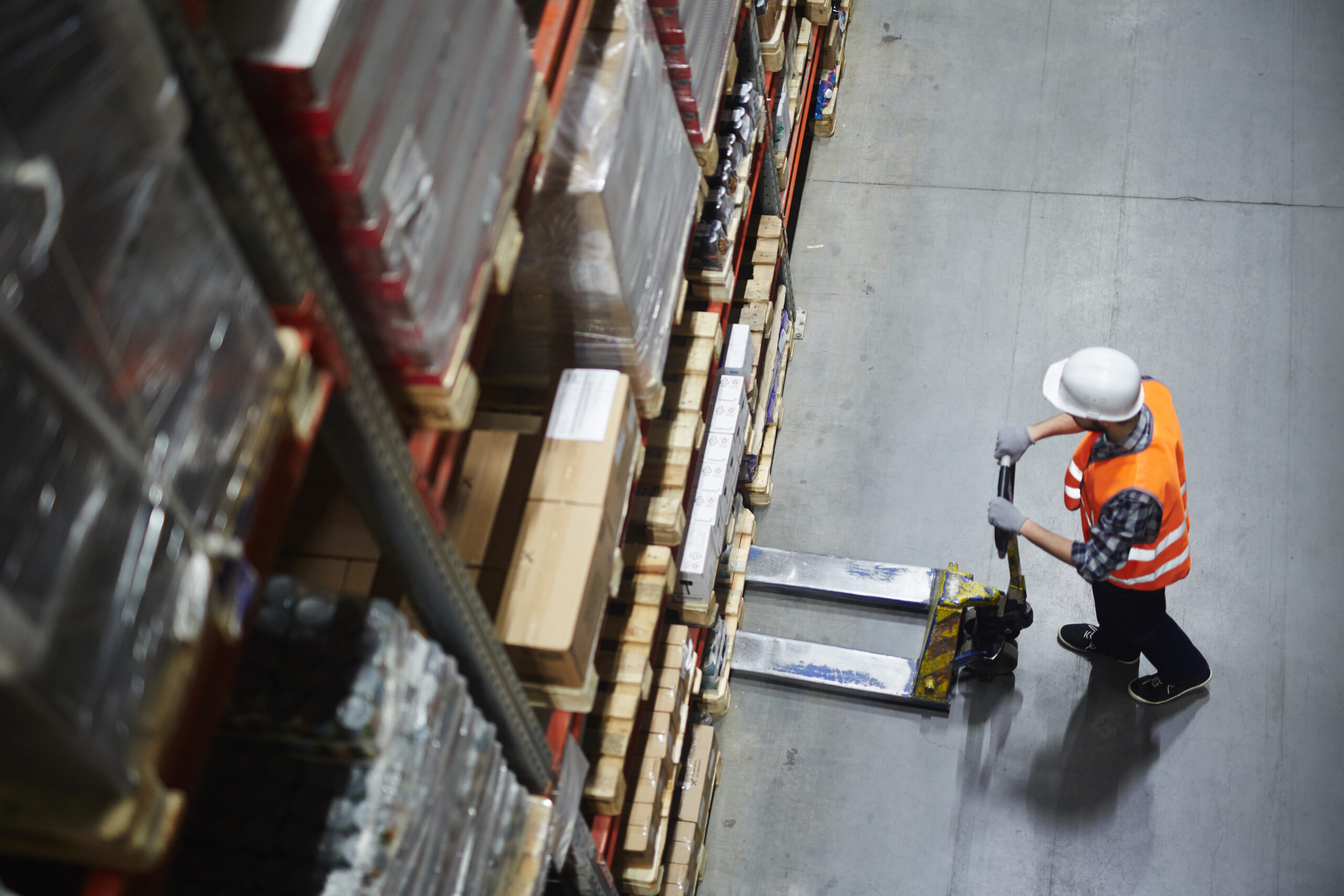
Preparing for your first day in a warehouse job can seem a little bit daunting with so many things to consider, so the purpose of this blog post is to make sure you’re ready when that day comes and can get your warehousing career off to a flying start. It’s hard to cover all bases in telling you what to expect from warehouse work as there are several different roles available in this environment. Ultimately, warehouse roles cover a wide range of responsibilities within the supply chain and logistics industry. However, typical tasks include receiving, storing, and dispatching goods, often involving the use of forklifts, pallet jacks, and other equipment. Accuracy is also an important part of any warehouse job, as you’ll need to ensure the correct items are picked and shipped and inventory is accurately recorded. And in a busy warehouse environment, which moves at a fast pace and involves the use of heavy machinery or equipment, safety is a top priority, with mandatory training required and rigid adherence to health and safety regulations.
Warehouse roles often involve physically demanding work, with manual handling and heavy lifting, so you’ll need a degree of physical fitness to cope with these demands. And shift work, including nights and weekends, is common in the industry to support round-the-clock operations. This doesn’t cover everything you can expect from your time in a warehouse, but glosses over the main duties that you may be called upon to do.
Knowing what to expect from your first warehouse job is one thing, but preparation for that all-important first day is another. Being well-prepared not only helps you to make a positive first impression on your employer but also ensures your safety on the job. Prior to your first day, it’s essential to familiarize yourself with the company’s specific policies, procedures, and safety guidelines. You also need to ensure you have appropriate work attire, including steel-toed boots, a high-viz vest, and any other personal protective equipment you’ll need. Understanding the basics of warehouse operations, such as inventory management and equipment operation, will also help you on your first day. And you’ll need to be mentally prepared for the fast-paced nature of warehouse work, so solid preparation ensures that you’re ready to go from day one and can be confident on your first day.
You can read more about how warehouse employees play a crucial role in the logistics and supply chain of goods across the country. But, for this post, we’re going to delve a little deeper into how to prepare for your first day, why safety matters in warehouse environments, the various tools and equipment you’ll be asked to use, how to make a positive impression on your employer, and much much more.
Preparing for your first day

The importance of a good night’s sleep
Getting a good night’s sleep before your first shift in a warehouse is of paramount importance, particularly with respect to warehouse safety. Warehouse work is physically demanding and often requires long hours of standing, lifting heavy objects, and operating machinery. Therefore, decent sleep is crucial for maintaining the focus, stamina, and awareness needed to perform these tasks safely and effectively. It’s well known that fatigue can impair decision-making and reaction times, increasing the risk of accidents and injuries. It can also affect your ability to work at the fast pace required in warehouse environments. So, prioritizing a full night’s rest (a good eight hours, if you can get it) ensures that you arrive for your first day of a warehouse job with the energy and mental clarity necessary to meet the challenges of the job.
Dressing appropriately for warehouse work
Dressing appropriately for warehouse work is one of the best industrial job tips you can follow, as it’s essential for both comfort and safety. In fact, if you’re considering more broadly if the industrial sector is the right fit for you, then it’s definitely worth following these tips. There are certain items, in terms of workwear, which are an absolute must and form part of the uniform for any warehouse professional. These include…
Safety gear: Most warehouses require you to wear safety gear, including steel-toed safety boots to protect your feet from heavy objects, safety goggles or glasses to shield your eyes from debris or chemicals, and ear protection if the environment is noisy.
General workwear: This includes comfortable, durable clothing that allows for ease of movement. Many workers go for work pants or overalls and a long-sleeved shirt, to protect the arms. Avoid loose-fitting clothing that can get caught in machinery.
Layers: As temperatures can fluctuate throughout the year, it’s best to layer your clothing so you can adjust to the climate. A moisture-wicking base layer can help keep you dry (sports tops are good for this), while a thermal or fleece layer can keep you warm in colder weather.
High-visibility (high-viz) gear: If you’re working in a warehouse with moving vehicles or equipment, you may be required to wear high-visibility clothing, such as a brightly colored jacket or vest to ensure you’re easily seen by others.
Gloves: Depending on the nature of your tasks, gloves may be necessary to protect your hands from cuts and scrapes, or from handling cold materials.
Personal Protective Equipment (PPE): Always wear any additional PPE required for your specific job, such as helmets, respirators, or safety vests.
Adhere to company policies: Many warehouses have specific dress code policies. Make sure you follow your employer’s guidelines and recommendations regarding clothing and safety attire.
Arriving early and prepared
Arriving early and fully prepared for your first day in a warehouse job is of utmost importance. Being on time demonstrates your commitment and reliability to your new employer, creating a positive impression right from the start. Arriving a little early may also allow for a short introduction, some quick safety training, a briefing for the day’s work, or just allow you to relax a little before you start. In a warehouse setting, being prepared means having the necessary safety gear, workwear, and any required personal protective equipment (PPE) ready and in good condition. This ensures your safety and the safety of those around you. Being prepared also means having read up on your company, their background, and their policies and procedures. All of the above will allow you to adapt more quickly to your new role, giving you a smooth start to your first day in the warehouse and helping to settle any nerves.
Safety first: warehouse safety measures

Common safety protocols in warehouses
Warehouses can be dangerous places – lots of heavy items, items stacked on high shelves, lots of lifting and pulling, and lots of machinery and equipment with moving parts. This is why there are some common safety protocols in warehouses all across the country, which are vital when it comes to protecting workers and maintaining a secure working environment. These protocols typically include:
Training: Adequate training for everyone who works in a warehouse is essential. You must be trained in the safe operation of machinery like forklifts and pallet jacks, as well as general safety procedures, including emergency protocols.
Safe material handling: The teaching of proper techniques for lifting and carrying heavy objects, to minimize the risk of strains and musculoskeletal injuries.
Clear signage: Warehouses use signage to indicate safety zones, warn of hazards, and provide directions. This helps prevent accidents and guide workers to the right places in the warehouse (and help them to avoid the dangerous ones).
Hazardous materials handling: If a warehouse deals with hazardous materials (certain chemicals, for example), employees must be trained in their safe handling, storage, and disposal, in compliance with health and safety regulations.
Fire safety: All warehouses are equipped with fire safety measures, such as fire extinguishers, sprinkler systems, and emergency exit plans. Regular fire drills are often conducted to ensure everyone knows what to do if a fire happens to break out.
First aid: First aid kits should be available, and designated staff should be trained in first aid and CPR so that they can respond to injuries or medical emergencies quickly.
Vehicle safety: If the warehouse involves the use of vehicles, such as forklifts, traffic management, and pedestrian safety measures will be put in place, including clearly marked walkways and safety barriers.
Housekeeping: Maintaining a clean and organized workspace reduces the likelihood of trips or falls, as well as fire risks. Regular housekeeping procedures are essential, particularly if dealing with large items which come with lots of packaging.
Reporting and investigation: Protocols for reporting and investigating accidents, injuries, near misses, and safety concerns help to identify what caused them in the first place so preventative measures can be put in place. Adhering to these safety protocols is essential in US warehouses to prevent accidents, ensure a healthy work environment, and comply with legal and regulatory requirements. Employees and employers share the responsibility for maintaining a safe workplace.
Handling hazardous materials and preventing accidents
In terms of warehouse job tips, knowing how to handle hazardous materials correctly is top of the list when it comes to maintaining a safe work environment. Strict safety procedures are in place to prevent accidents and minimize the risks associated with these materials. As a warehouse worker, you’ll be required to undergo specialized training on the safe handling, storage, and disposal of hazardous substances, including chemicals, flammable materials, and potentially toxic substances. This training includes learning how to identify hazardous materials, understanding Material Safety Data Sheets (MSDS), and using appropriate personal protective equipment (PPE) when working with these items.
Warehouses will also implement other safety measures, such as proper labeling, secure storage, and the use of containment systems to prevent leaks or spillages. Inspections, emergency response plans, and the availability of spill kits and eye-wash stations are essential for ensuring employees are prepared in the event of an accident. Above all, these measures protect the health and wellbeing of warehouse staff, but it’s also important to note that they’re required by law, to comply with regulations governing hazardous material handling. You’re certainly not expected to know everything about handling hazardous materials and preventing accidents on your first day in your warehouse job, but you will be expected to know this information as you settle into your role.
Navigating warehouse equipment

Tools and equipment commonly used in warehouses
Whether it’s your first day or your five hundredth day working in a warehouse, it’s important to familiarize yourself with the whole variety of tools and equipment used to manage inventory, transport goods, lift things, and ensure efficient operations. You’ll need to know about this equipment and how it works to comply with warehouse safety rules and ensure a long and successful warehouse career overall. Commonly used tools include:
Forklifts: These are essential for moving heavy and bulky items around the warehouse and storing them in the correct locations, as well as loading and unloading shipments. Being a forklift operator can take you far in your warehouse career.
Pallet jacks: Used for lifting and moving pallets within the warehouse. They come in both manual and electric models.
Conveyor systems: Automated conveyor belts, or rollers, are used to transport goods efficiently within the warehouse, reducing manual handling and the risk of strains or other injuries.
Hand trucks: These are commonly used for moving smaller loads and are especially useful for transporting boxes or cartons.
Racking and shelving: These storage solutions maximize space within the warehouse, allowing efficient storage and easy access to products.
Barcode scanners and Radio Frequency Identification (RFID Technology): These tools help with inventory tracking, order picking, and stock management.
Material handling equipment: This includes items like drum handlers, carts, and scissor lifts, which are used to transport and handle various materials safely.
Packing stations: This is where (unsurprisingly) goods are packed. Stations will be equipped with tools such as tape dispensers, scales, and packing materials to prepare goods for shipping.
Lifting equipment: Hoists, cranes, and jib arms are used for lifting heavy loads in the warehouse.
Warehouse Management Software (WMS): Digital tools and software are essential for managing inventory, tracking orders, and optimizing warehouse processes.
Wrapping machines: Automated machines for wrapping and securing pallets of goods.
Bins and containers: Various types of bins, totes, and containers are used to store and transport items.
Dock equipment: Dock levelers, seals, and shelters help with the loading and unloading of goods at the warehouse’s loading docks.
Safety barriers and guardrails: These protect workers from potential hazards, especially in areas with heavy equipment and traffic.
Measuring and inspection tools: Tools like tape measures and calipers are used for quality control and measuring product dimensions, to ensure they comply with regulations.
A combination of all of these tools, along with many others (too many to mention in one blog post), helps warehouses to improve safety and run smoothly and efficiently. Some warehouses will use industry-specific tools, but those mentioned above should be common to all warehouses.
Your first day on the job
What to expect on the first day of your new warehouse job
The first day of your warehouse job may well be a whirlwind of information, introductions, form-filling, and training, so try to take a deep breath, maintain composure, and take as much in as possible. No one is expecting you to understand everything from day one – it takes time. It’s important to make a good first impression on your new employer though, so – as previously mentioned – arrive early, make sure you’re well-prepared, and start with the right attitude. Here are a few things you can expect from your first day:
Orientation and paperwork: To begin with, make sure you report to the correct location for new hires, where you’ll most likely undergo an orientation session. This may include completing and signing paperwork related to your employment, such as tax forms and safety agreements.
Safety briefing: For any warehouse role, expect a comprehensive safety briefing on your first day, as standard. You’ll learn about the warehouse’s specific safety protocols, including the proper use of personal protective equipment (PPE) and how to respond to emergencies.
Tour of the facility: It’s highly likely, if not an absolute certainty, that you’ll have a tour of the warehouse facility. This tour will introduce you to various areas, storage systems, equipment, and emergency exits.
Introduction to colleagues: Without a doubt, on your first day, you’ll meet your new colleagues and possibly your supervisor. This is an opportunity to ask questions and get to know your co-workers. It’s good to build a relationship with them, as it’s likely you’ll be working with them day in and day out.
Uniform and PPE: If you haven’t received your work uniform or PPE ahead of your first day, you may be provided with these items or given instructions on how to obtain them.
Training: Depending on your job role, you may receive specific job training which begins on day one. This could include how to operate machinery, inventory management, or order-picking processes. Pay close attention and ask questions as needed.
Breaks and lunch: You’ll learn about the break and lunch schedules for your new employer. Warehouse work can be physically demanding, so understanding when you can take breaks is essential.
Assignments: You might be given your first tasks or responsibilities for the day. These tasks could include assisting with shipping and receiving, inventory checks, or picking orders. Again, don’t worry if you don’t understand everything right away – it takes time. If you’re unsure of anything, you could always ask one of your new colleagues for help.
End of the day: At the end of your first day, you’ll typically receive feedback on your performance from your shift/line manager. This is also your chance to address any questions or concerns you may have. Your first day at a warehouse job is an opportunity to make a positive impression, learn about your new workplace, and build confidence in your new role. Being attentive, following safety protocols, and demonstrating a strong work ethic will help to get you off to a good start.

Some tips on making a good first impression
We’ve sort of touched on it above, but one of the top tips for working in a warehouse is about making a good first impression, on both your employer and your individual colleagues. Getting off to a positive start will keep you in good standing and will boost your confidence overall. Here are some top tips to ensure you get off to a great start – some relevant to all jobs, some specific to warehouse roles in particular.
- Punctuality: Plan your commute in advance, to make sure you arrive early or on time for your shift. This demonstrates your reliability and commitment to your new job.
- Wear professional attire: Wear the appropriate work uniform and personal protective equipment (PPE), dressing in accordance with the safety guidelines and company dress code.
- Active listening: Pay close attention during safety briefings and training sessions. Listen to your colleagues, supervisors, and trainers, and ask questions when necessary.
- Safety first: Prioritize safety above all else. Follow safety protocols, use PPE, and report any unsafe conditions or incidents right away.
- Teamwork: Warehouse work often involves collaboration among employees. Be a team player by helping your colleagues and communicating effectively with them.
- Respect and courtesy: This is a more general point, but treat your colleagues, supervisors, and all employees with respect and courtesy. A friendly and respectful demeanor goes a long way in helping you to settle into your new role.
- Follow instructions: Always follow the instructions and guidelines given by your supervisor. It shows that you’re paying attention, and ensures consistency and safety in warehouse operations.
- Problem-solving: Show that you can be resourceful and adaptable. If you encounter challenges, approach them with a problem-solving mindset and ask for help if you need it – no one will judge you for this on your very first day.
- Professional communication: Communicate clearly and professionally with colleagues and supervisors right from the beginning. Effective communication is essential in a fast-paced, busy, noisy, and (sometimes) dangerous work environment, like a warehouse.
- Be open to feedback: Welcome feedback and use it to improve your performance, from day one. Demonstrating a willingness to learn and grow will help to advance your warehouse career.
Be open to being flexible with your availability
A willingness to be flexible with your availability for a warehouse job comes with several advantages, so you should let your employer know if you’re free to work certain shifts, including weekends and nights, from day one. Firstly, this enhances your employability as many warehouses operate around the clock or need coverage during peak hours, or across peak seasons, such as the run-up to Christmas. By showing a willingness to adapt your schedule, you immediately mark yourself as being a valuable team member, giving you greater job security. Flexibility in terms of your hours can also lead to more opportunities for overtime, which can significantly boost your earnings. And it shows your commitment to the job, including your desire to contribute to the smooth running of the warehouse. One particular type of work you may want to consider is night shifts. These can be tricky to navigate, but come with advantages such as increased pay rates for working unsociable hours and the ability to spend time with your family during the day. You can find out all about working during the night in our comprehensive guide on how best to prepare for a night shift. Overall, being flexible with your availability in a warehouse job is a win-win situation, benefiting both you and your employer and helping you to stand out right from the start.
How to prepare for your first day in a warehouse job: in summary
When it comes to warehouse job tips, knowing how to successfully make your way through your first day is right up there in terms of importance. The most basic advice is simply to be prepared: read up on the company you’re going to be working for (what they do, how they operate, policies and procedures), make sure you have a grasp of the fundamentals of warehouse operations, ensure you have the right working gear (clothes and safety equipment), get a good night’s sleep ahead of your first day, arrive on time or even a little early, and be prepared to ask questions if you don’t understand something. It also shows your awareness of job-site safety protocols, as without these in place, a warehouse can make for a dangerous environment. So listen carefully on day one, and show your willingness to undertake any training necessary to better understand your role and help to prevent accidents. And make sure you familiarize yourself with the equipment you may be required to use in your warehouse role, such as pallet jacks and forklifts. You won’t be expected to know how to use them right away, but in time you’ll likely have to work with them. Above all, look to make a good impression on your employer right from the start.
Be punctual and professional, listen carefully, show yourself to be a good team worker, be respectful and polite, and be open to all feedback. And, if you can, show that you’re open to working all hours, including night shifts, as this will cast you in a positive light to your employer. Keep all of the points in this blog post in mind, and we’ve no doubt you’ll do absolutely great on day one of your new warehouse job – good luck!
Download the Indeed Flex app today and benefit from a world of temporary work opportunities across all different industries and employers.








